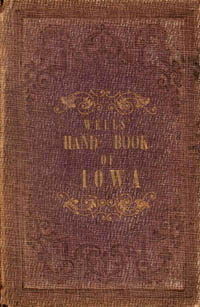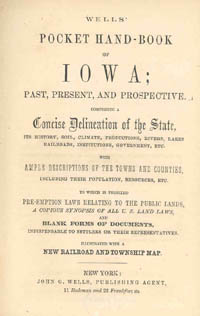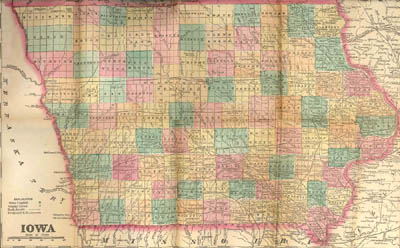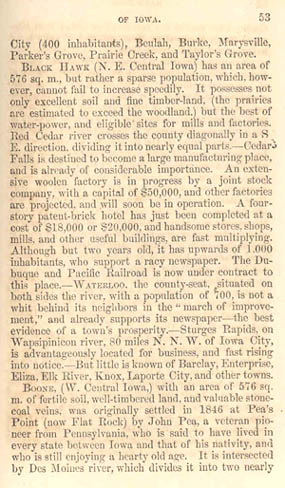
In the spring of 2004, Dean of Library Services Marilyn J. Mercado determined that, by standard counting methods, the Rod Library at the University of Northern Iowa was approaching the addition of its one millionth volume. She asked Special Collections Librarian and University Archivist Gerald L. Peterson to look for a book that would be appropriate for the occasion. The Library would, at the same time, be honoring the memory of Donald O. Rod, former Director of Library Services who died August 27, 2003, as well as the fortieth anniversary of the completion of the first phase of the Rod Library.
Gerald Peterson scoured catalogues and talked with book dealers for a month with several possible criteria in mind. First, because of UNI’s historical roots and because Mr. Rod was a native Iowan, the ideal book would relate to Iowa. It should be old, because Mr. Rod appreciated older, rare books and because the Library was looking back at its own history. It might relate to education, since UNI was solely devoted to teacher training until 1961. It could even relate to Mr. Rod’s Norwegian heritage or to his interest and expertise in library architecture. We thought that finding a book that met all of these criteria, or even most of them, would be difficult, and we were correct. Just about any book that came close to meeting these criteria was already in the Rod Library collection.
Consequently, the Library chose a book that met perhaps the most important criterion: that is, that the book relate to Iowa’s historical roots. The book is described in the bibliographic citation below.
Author: Wells, John G.
Title: Wells’ pocket hand-book of Iowa; past, present and prospective; comprising a concise delineation of the state, to which is prefixed pre-emption laws relating to the public lands, a copious synopsis of all U. S. land laws, and blank forms of documents, indispensable to settlers or their representatives; illustrated with a new railroad and township map.
Place and Date of Publication: New York, 1857

This book, which includes a color map of Iowa, is rare, especially in the fine condition of our volume.
Books like this, often called emigrant books, were popular in the middle nineteenth century when Midwest lands were opened for settlement. People who were considering a move to the Midwest bought books like these to find the best places to farm, start businesses, and raise families. The books were usually small, like our volume, in order to fit conveniently into a person’s pocket.
Wells’ Handbook of Iowa begins with a Preface in which the publisher claims that the information contained in the book is accurate. He claims that a large portion of the manuscript “was submitted to the revision of an intelligent gentleman, a resident of Iowa, who is familiar with its history and present condition.” While a reader can scarcely take a publisher’s claim at face value, this book does seem to have solid, authoritative, detailed information with a minimum of padding.
The preliminary section of the book is devoted to the legal process by which a person could claim public land. It includes a statement of the law as passed by the US Congress, an interpretation or amplification of that law, and legal forms to be used in filing a land claim. Typically, a person could settle on and claim as much as a quarter section of public land (160 acres) for as little as $1.25 per acre, though the price could be higher.

Chapter I considers the history, boundaries, soil, and climate of Iowa. The author especially praises the soil: “For richness and adaptation to the production of all the different grains, grasses, fruits, etc., it is admitted to be unsurpassed in the country.” He describes the climate as “temperate and healthy”. And he goes on to talk about the prospects for crops, of which wheat, potatoes, onions, corn, and fruit look especially good. He notes the 1857 population as about 600,000. Among Iowa “curiosities” he notes the caves and sinkholes of northeastern part of the state.
Chapter II considers the prospects for mineral production in Iowa. Coal and lead are, appropriately for that day, at the top of this list. But Wells also notes the prospects for iron, copper, and limestone. He was also aware of the great gypsum deposits in north central Iowa.
Chapter III considers rivers, lakes, and creeks. At a time when land transportation was still in its early development, knowledge about the course and flow of water was vital to settlers. Likewise, entrepreneurs wanted to know where they might build and develop mills to grind grain. Wells’ survey mentions both the Red Cedar and the Turkey Rivers. Both are noted for their waterpower potential.
Chapter IV is a curious little compilation of suggestions for success in Iowa. Potential immigrants are first advised to seek the best land. A settler “who is willing to penetrate unsettled portions, and endure the privations incident to a frontier life, can lay for himself and his children, the foundations of a fortune and a home . . . .” The writer cautions that settlers must not expect to find rich land, accessible water, and first-rate timber all laid out for him in a single location at $1.25 per acre. Good land would likely cost more, maybe $5 or $10 per acre. Neither, however, should settlers expect to find the state a desolate wasteland. But those who were ready to work would succeed. The writer suggests Osage Orange hedges to enclose fields, and also advises that wool, cattle, and dairy production might be good economic enterprises.
Chapter V contains a description of the counties and principal towns of Iowa. Many counties had been organized since the 1850 census, so information about these counties was new. Also, a number of counties, especially in the north central and northwest portions of Iowa, are described as “not yet organized”. This meant that the borders, and perhaps even a county seat, were known, but there would likely be little or no local government and few settlers there. At least one county, Buncombe, was never organized under that name. Black Hawk County, with “a rather a sparse population”, gets a fairly long description. Waterloo, the county seat, is noted as supporting “its newspaper—the best evidence of a town’s prosperity.” Cedar Falls “is destined to become a large manufacturing place.” A woolen factory, capitalized at $50,000, and other factories were projected. A new hotel and other substantial enterprises receive praise. The one thousand residents, who looked forward to the arrival of the railroad, are noted as supporting “a racy newspaper.”

Chapter VI is devoted to railroads. Even though Iowa railroads in 1857 were long on promise and short on miles of track actually laid, this chapter was very important to readers of the handbook. Farmers and entrepreneurs appreciated the importance of proximity to railroads for their commercial success. Railroads were to nineteenth century Americans what interstate highways are to us today. This chapter describes the railroads that existed in Iowa at that time as well as those that were being planned. And it also notes stagecoach and river distances.
Chapter VII describes educational, charitable, and penal institutions. The University of Iowa, which opened in the spring of 1856, is noted and one particular department, the Normal School, is cited. The Normal School, which annually admitted fifty students tuition-free, educated teachers for the schools of Iowa. The independent Iowa State Normal School, predecessor to the University of Northern Iowa, was still twenty years in the future.
Chapter VIII talks briefly about government and finances. It notes the timing of elections and constitutional provisions for state government. Total taxes assessed by the state for 1854 were $90,000.
Gerald L. Peterson
Special Collections Librarian and University Archivist
Rod Library
University of Northern Iowa
June 2004
